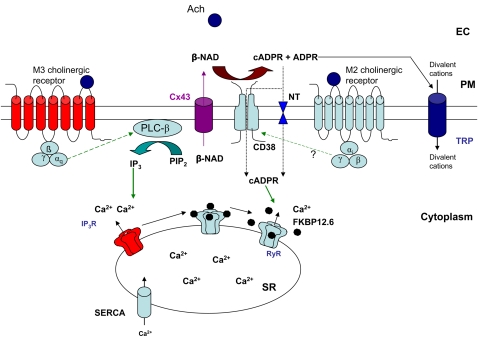Figure 2.
An integrative model of differential recruitment of cellular calcium mobilization mechanisms. Acetylcholine acts on M2 and M3 subtypes of muscarinic cholinergic receptors on the ASM cells to elicit a calcium response. M3 subtype of receptor, which is coupled to Gαq protein, recruits phospholipase C-β (PLC-β) and generates inositol 1,4,5-tris-phosphate (IP3). IP3 acts on IP3-receptor (IP3R) to increase its open probability to release Ca2+ from SR. Activation of the M2 subtype of receptor, which is coupled to Gαi protein, recruits CD38/cADPR signaling pathway. The β-NAD is transported out from the cytoplasm of the myocyte by connexin 43 hemichannel proteins (Cx43). cADPR generated by CD38 is transported back into the myocyte cytoplasm either through specialized nucleoside transporters (NT) or via the oligomerized CD38. ADPR, the predominant product of the CD38 enzymatic activity, acts on transient receptor potential (TRP) channels to elicit influx of divalent cations including Ca2+. Upon interaction of cADPR with RyR (direct or indirect), dissociation of FK506-binding protein 12.6 (FKBP12.6) from RyR results in open probability of the ion channel and releases SR Ca2+. SR Ca2+-ATPase 2 (SERCA2) pumps the cytosolic Ca2+ back into SR to replenish the SR Ca2+ stores. The TRP channels also play major role in replenishing the SR Ca2+ store through store-operated Ca2+ entry (SOCE). EC = extra cellular space; PM = plasma membrane.

